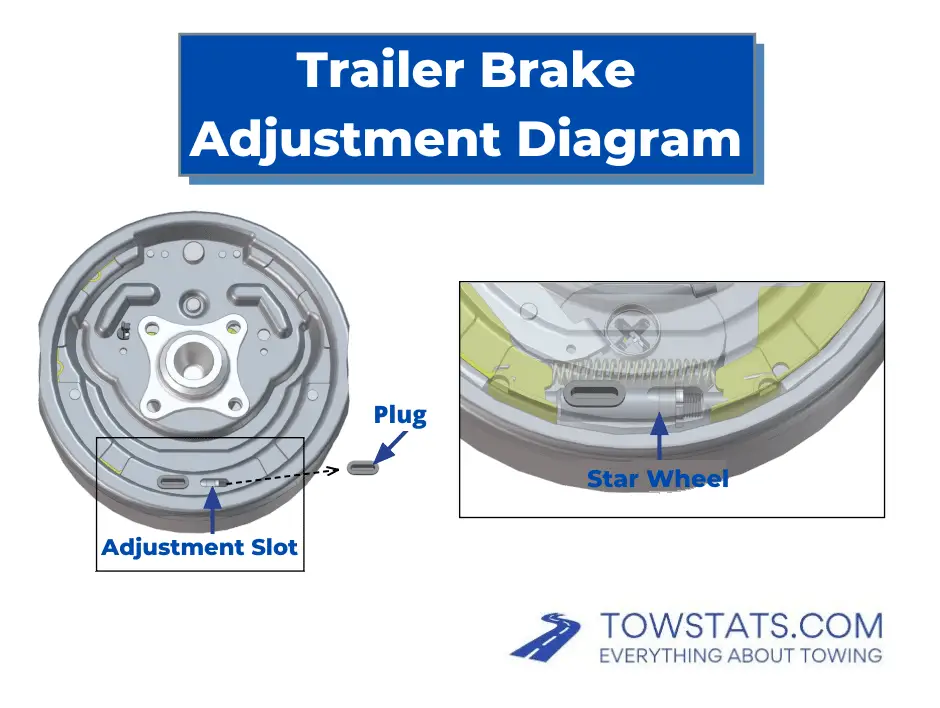If you’re like most people, you probably don’t think about your trailer brakes all that often. If you want to ensure safe and smooth towing, it’s important to know how to adjust trailer brakes for optimal performance.
Today we will explain the process of adjusting trailer brakes so that you can do it yourself quickly and easily.
Why Do Trailer Brakes Need Adjustment?

Over time and use, the linings and drums of your trailer breaks wear down, providing more clearance between the brake lining and drum surface.
As this clearance grows, you’ll notice reduced performance from your trailer brakes.
Some people combat this by increasing the gain on their electric brake controller, but that isn’t the safest choice.
How To Adjust Trailer Brakes
- Gather Your Supplies
- Chock The Wheels
- Jack Up The Trailer
- Remove The Brake Adjustment Hole Cover
- Tighten The Brake Adjustment Wheel
- Test The Tire
- Replace The Brake Adjustment Hole Cover
- Torque Your Tires
How To Adjust Trailer Brakes: Step-By-Step Guide
Gather Your Supplies

You’ll need the following items to adjust your trailer brakes:
- Rollaway jack or bottle jack
- Jack stands
- Wheel chocks
- Flathead screwdriver or brake spoon
- Flashlight
- Gloves
- Safety Goggles
Chock The Wheels

When working underneath a trailer, you’ll want to chock all wheels to ensure there is absolutely no movement.
Do not skip this step!
Jack Up The Trailer

Lift one end of the trailer axle off the ground at a time using a rollaway jack or bottle jack.
This allows the other wheels to carry the load.
Jack your trailer up high enough where you can spin the tire freely without it touching the ground.
Always be sure to lift the unit by the frame, and never by the axle or suspension.
Never go under your trailer unless it’s supported by jack stands, as unsupported trailers can fall causing injury or death.
Remove The Brake Adjustment Hole Cover

On the back side of the wheel, you’ll see one or two rubber or plastic plugs that are usually oval-shaped.
Remove those with a flathead screwdriver and set them aside in a safe place.
Tighten The Brake Adjustment Wheel
Inside the brake adjustment hole you will see the brake adjustment mechanism, which is usually located below the brake drum.

It’s a star wheel or splined nut that you can adjust with a screwdriver or brake spoon.
Adjust the nut up by inserting the screwdriver or brake spoon horizontally into the hole and pry downward.

This movement turns the nut in the upward direction.
To loosen the brake adjustment, insert the screwdriver or brake spoon horizontally into the hole and pry upwards.
Pay attention to how many clicks of the nut it takes to get your tire to a point where the tire spins freely with minimal drag.
You can use that same number of clicks as a reference point when adjusting the other trailer brakes on your trailer.
Test The Tire
You’ll want to adjust the trailer brakes until you hear a light drag but the tire rolls freely.
That ensures you’ve got your brakes adjusted properly.
Replace The Brake Hole Covers
Push the rubber or plastic plugs back in to the adjustment holes to keep debris out.
Torque Your Tires

Refer to your trailer brake manual or a sticker on the unit that has the torque value.
Torque your tires to this setting using a socket and extension bar in a star pattern on the lug nuts.
Hit The Road
Now that you’re finished adjusting your trailer brakes, it’s time to get back out on the open road.
Now is a good time to make sure you have your trailer tires set to the right tire pressure for towing.
When you’re on the road, always obey the proper speed limit when towing and general towing safety.
Frequently Asked Questions
It’s recommended that your trailer brakes be checked and adjusted every 3 months or 3,000 miles, whichever comes first.
The good news is that trailer disc brakes are self-adjusting and don’t need manual adjustment.
To tighten trailer brakes, pry the star wheel or splined nut upward using a downward motion on your screwdriver or brake spoon.
To loosen trailer brakes, pry the star wheel or splined nut downward using an upward motion on your screwdriver or brake spoon.
You only need to break in trailer brakes if you’ve installed new brakes on your trailer.
This applies to both self-adjusting and manual adjusting electric trailer brakes.
If you’re manually adjusting a set of existing trailer brakes, there is no need to “break them in”.


